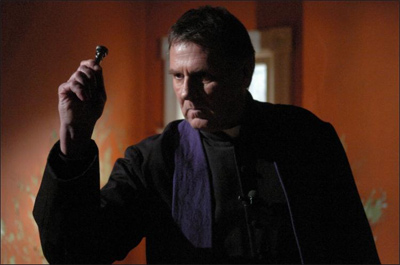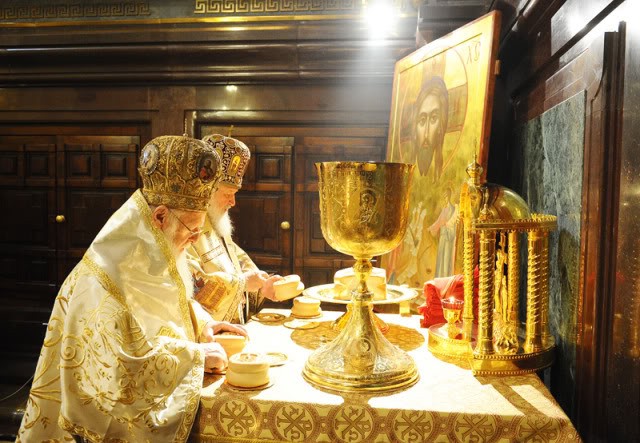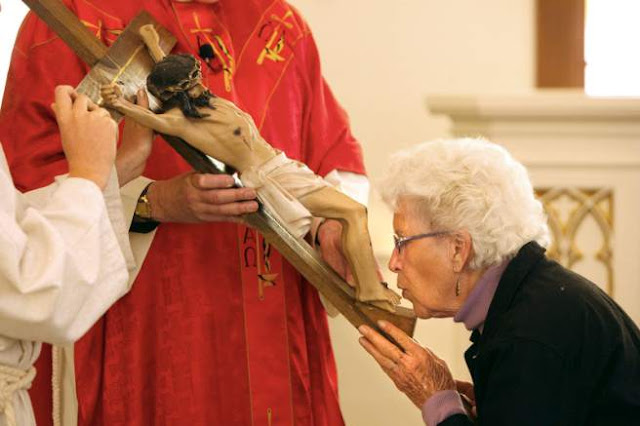A teacher once told me that if Jesus Christ had been killed in an electric chair, then electric chairs would be on necklaces and church steeples, instead of a cross. Christians put crosses everywhere: above graves, in gardens, atop cathedrals, and crucifixes lead Sunday's priestly procession.
To outsiders of the Christian faith, the accoutrement, rituals, symbology, singing styles, and costumes seem odd.
Centuries after his death, mankind "layered on" materialistic accessories. Ancient Romans sought power and increasing spheres of influence, so they overlapped the new Christianity above existing pagan religions within their empire. It has continued in force to this day.
After the ancient Greeks were conquered by the Romans, the Grecian gods were renamed as Roman gods (but kept their "job descriptions"). Even after the Roman Catholic Church was formed and a pope created the Gregorian Calendar (that we use today), the names of the months are still named after ancient Roman gods! Statues of pagan gods still adorn newly-constructed buildings, clothes and gardens.
As an outsider, if you look at the rituals that Christians partake of, they might seem weird. Here are some:
Seen above, men are grouped by colored outfits and they kneel before a church-leader to worship a God, His Son, and an overlapping Holy Spirit. Nobody is certain about what the Holy Spirit is, but it seems to occupy the space of polytheistic entities from older religions.
Seen below, water is poured on people during their indoctrination.
Sometimes, as seen below, water is sprayed on worshippers as a blessing.
Other times, Holy Water is flicked on the congregation to keep away evil spirits. (In the image above, the Easter baskets are a holdover from pagan customs).
The Catholic Church has documentation for how priests can use Holy Water to conduct an exorcism to repel demons and evil spirits (above).
Parishioners merely "enter" a church, but purely symbolic processions and recessions are used for the officiants (below).
(Above) Episcopal churches give a pointed weapon to their Vergers (originally used to beat back over-enthusiastic or unruly worshippers), and the Verger leads the processions.
There is an official separation of church & state, but Catholic echelon are treated like royal dignitaries and national leaders.
Looking at the hats, robes and "seemingly requisite" facial hair might make Christian priests and bishops look unique. (always lots of gold, the human symbol of power, wealth, importance) A friend once commented, "They look like wizards, but they're very stoic."
Southern Baptist church leaders seem to agree that an effusive and joyously loud "celebration of mass" is needed.
Yet, everybody gets dressed up in different colors during religious "seasons". Officiants with enough bankroll might have several entire sets--of the same uniform--in requisite colors: green, blue, red, purple, white, gold. I don't think God ordained any rules about religious garb, but mankind did.
(People don't dress in costume for yoga or Zen reflection, like they do for prayer or Evening Vespers).
In fact, it's the only organization that gets volunteers and employees to dress up in the centuries-old style of tunics with ropes around the waist, like below...
Such outfits are worn wherever the processions go... even through the streets like a parade.
Speaking of parades, certain nationalities celebrate festivals for Christ and also for individual saints or the Virgin Mary (both images below):

The Chinese and Japanese cultures use mini-temples and shrines in their homes and businesses for reverence of ancestors and polytheism. Christians might scoff at such things, yet they similarly have shrines in their homes...
...and their domestic gardens.
During Christmas, they add additional "shrines" as Nativity Scenes. Unbeknownst to them, those scenes actually testify that Christ was born in summer, when shepherds brought their flocks to graze. (The Catholic Church moved Christ's birthday to winter as a recruitment tactic to lure believers who had preexisting festivals in December).
You might want to sing during church, but there are certain "styles" that are acceptable in each faith. There is a prescribed book of allowable songs, called hymns. They are sung in certain styles/tempos, depending on the branch of Christianity. In some branches, the music is only sung by cantors. Somewhere along Evolution, the pipe organ was chosen as the "churchly" musical instrument. If you want to sing in the church choir, you need to wear a 5-piece outfit.

Members of the Greek Orthodox faith explained to me that their church still uses things for no apparent reason other than tradition. For example, the gold "fan" below...
Centuries ago, it had feathers attached and was used to "cool" the priests. Nowadays, the feathers are gone, and they keep manufacturing and buying them ($2,000 each)... for no purpose.
Another Greek man told me that the lanterns near each icon are merely expensive "symbolic accessories". Centuries ago, they actually lit the icons, but nowadays, churches keep using them due to tradition--except they're often hung high so as not to block the view.... thus, the lanterns don't illuminate anything (see below). But churches buy them and constantly refill them.
Bishops carry a staff (with a crook), to symbolize them as God's shepherds, herding the followers (sheep).
I grew up attending Lutheran services. After being an acolyte and crucifer, I became a Communion Assistant. Admittedly, some of the accoutrement on the altar is unnecessary. Even my pastor told me so, including the cover that is draped over the chalice (below). The color-matching "envelope" on top of it is manufactured/sold to hold "napkins". Do they NEED to be there? No. But it's "good theatre"... because "it's all about the presentation".
Thusly, churches with enough funds can have a set in every color, for each religious season (to match the priestly outfits).
Underneath the cloth cover, the chalice and paten are covered by yet another piece of cloth/cardboard! (below) It was designed to keep bird poop off the Sacraments, in medieval open-air churches. But, we don't need them now.
The need to use precious metals for church objects was a theatrical "membership retention" method. Jesus probably used a mere copper or pewter cup during the Last Supper.
To a Buddhist, the notion of eating a dead man's body and blood might seem disturbing,
Greek priests have a unique way of stabbing, slicing and preparing the Communion Bread--which occurs out of view from the congregation (below).
Naturally, the disposal of such food items "requires" specially constructed/installed receptacles... at extra expense.
To be able to partake in Communion, a member has a ritual of achieving First Holy Communion status (via classes and contributions to the church),
followed by a ritual to achieve Confirmation (via similar steps). Catering & retail companies love both occasions, as much as Baptisms and Weddings! [A Jewish friend of mine was disgusted that her rabbi actually created competing monetary bids between her family and another, to use their temple for a wedding on a particular day].
While we're talking about "eating", some denominations of Christians abstain from meat on Fridays. They believe that since Jesus died on a Friday, they should avoid red meat forever on Fridays. Other denominations only obtain from meat during Lent.
To enthrall followers (mostly uneducated medieval serfs and peasantry), church leaders used symbolism to teach the gospels and Old & New testaments. Halos were drawn over "holy entities".
Wings were drawn on Angels, to express their speed as God's messengers... just like Mercury, the messenger of the ancient Roman Gods.
Yet, churchgoers decorate their homes with angels and cherubs, despite the fact that they are incorrectly designed.
Angels and demons were created by the Catholic Church as a strategy to incorporate pre-existing deities (gods and goddesses) from ancient polytheistic religions.
Other times, Holy Water is flicked on the congregation to keep away evil spirits. (In the image above, the Easter baskets are a holdover from pagan customs).
The Catholic Church has documentation for how priests can use Holy Water to conduct an exorcism to repel demons and evil spirits (above).
Urns and relics are worshipped and given prominence.
Parishioners merely "enter" a church, but purely symbolic processions and recessions are used for the officiants (below).
(Above) Episcopal churches give a pointed weapon to their Vergers (originally used to beat back over-enthusiastic or unruly worshippers), and the Verger leads the processions.
There is an official separation of church & state, but Catholic echelon are treated like royal dignitaries and national leaders.
Superstitious or not, lots of things & people get blessed before "going into action":
Looking at the hats, robes and "seemingly requisite" facial hair might make Christian priests and bishops look unique. (always lots of gold, the human symbol of power, wealth, importance) A friend once commented, "They look like wizards, but they're very stoic."
Priestly garb varies wildly. Monks, nuns, priests and pastors tend to wear solemn black. Yet, the hierarchy gets to "stand out" with bright purple, scarlet and white.
Yet, everybody gets dressed up in different colors during religious "seasons". Officiants with enough bankroll might have several entire sets--of the same uniform--in requisite colors: green, blue, red, purple, white, gold. I don't think God ordained any rules about religious garb, but mankind did.
(People don't dress in costume for yoga or Zen reflection, like they do for prayer or Evening Vespers).
In fact, it's the only organization that gets volunteers and employees to dress up in the centuries-old style of tunics with ropes around the waist, like below...
Such outfits are worn wherever the processions go... even through the streets like a parade.
Speaking of parades, certain nationalities celebrate festivals for Christ and also for individual saints or the Virgin Mary (both images below):

The Chinese and Japanese cultures use mini-temples and shrines in their homes and businesses for reverence of ancestors and polytheism. Christians might scoff at such things, yet they similarly have shrines in their homes...
...and their domestic gardens.
During Christmas, they add additional "shrines" as Nativity Scenes. Unbeknownst to them, those scenes actually testify that Christ was born in summer, when shepherds brought their flocks to graze. (The Catholic Church moved Christ's birthday to winter as a recruitment tactic to lure believers who had preexisting festivals in December).

Members of the Greek Orthodox faith explained to me that their church still uses things for no apparent reason other than tradition. For example, the gold "fan" below...
Centuries ago, it had feathers attached and was used to "cool" the priests. Nowadays, the feathers are gone, and they keep manufacturing and buying them ($2,000 each)... for no purpose.
Another Greek man told me that the lanterns near each icon are merely expensive "symbolic accessories". Centuries ago, they actually lit the icons, but nowadays, churches keep using them due to tradition--except they're often hung high so as not to block the view.... thus, the lanterns don't illuminate anything (see below). But churches buy them and constantly refill them.
Bishops carry a staff (with a crook), to symbolize them as God's shepherds, herding the followers (sheep).
I grew up attending Lutheran services. After being an acolyte and crucifer, I became a Communion Assistant. Admittedly, some of the accoutrement on the altar is unnecessary. Even my pastor told me so, including the cover that is draped over the chalice (below). The color-matching "envelope" on top of it is manufactured/sold to hold "napkins". Do they NEED to be there? No. But it's "good theatre"... because "it's all about the presentation".
Thusly, churches with enough funds can have a set in every color, for each religious season (to match the priestly outfits).
Underneath the cloth cover, the chalice and paten are covered by yet another piece of cloth/cardboard! (below) It was designed to keep bird poop off the Sacraments, in medieval open-air churches. But, we don't need them now.
The need to use precious metals for church objects was a theatrical "membership retention" method. Jesus probably used a mere copper or pewter cup during the Last Supper.
To a Buddhist, the notion of eating a dead man's body and blood might seem disturbing,
yet Christians line up and/or kneel down to receive sips of wine and a wafer of bread, representative of Jesus's self-sacrifice.
In certain branches of Christianity, like the Greek Orthodox, they believe that the bread and wine becomes Christ's body and blood. Thusly, there are extra accouterment to catch any crumbs or drips, so as not to waste it (below).
Greek priests have a unique way of stabbing, slicing and preparing the Communion Bread--which occurs out of view from the congregation (below).
Naturally, the disposal of such food items "requires" specially constructed/installed receptacles... at extra expense.
To be able to partake in Communion, a member has a ritual of achieving First Holy Communion status (via classes and contributions to the church),
followed by a ritual to achieve Confirmation (via similar steps). Catering & retail companies love both occasions, as much as Baptisms and Weddings! [A Jewish friend of mine was disgusted that her rabbi actually created competing monetary bids between her family and another, to use their temple for a wedding on a particular day].
Wings were drawn on Angels, to express their speed as God's messengers... just like Mercury, the messenger of the ancient Roman Gods.
Yet, churchgoers decorate their homes with angels and cherubs, despite the fact that they are incorrectly designed.
Another form of church symbolism is the use of candles. Part of the "theatre" of church is illuminating the "stage lights" to signal that the service will start soon (even if 3 services occur in a row, the candles are lit and extinguished each time):
Some candles are lit for certain ceremonies. Some are lit when Communion is being offered. Others are lit for processions. A pascal candle is for holy days. You light candles for prayers/wishes (and hopefully the church doesn't charge you for that). Sanctuary (red) candles must remain lit forever. Candle companies make a fortune!
During Advent, Christians imitate pagans and make a wreath out of winter greenery and light candles on that.
Below, look at images that might seem peculiar to outsiders, atheists and civilizations of other religions/beliefs. Yet, different branches of Christians consider it part of their faiths.
(In the image above, notice the guy's head under the book to hold it up).
Some candles are lit for certain ceremonies. Some are lit when Communion is being offered. Others are lit for processions. A pascal candle is for holy days. You light candles for prayers/wishes (and hopefully the church doesn't charge you for that). Sanctuary (red) candles must remain lit forever. Candle companies make a fortune!
During Advent, Christians imitate pagans and make a wreath out of winter greenery and light candles on that.
Below, look at images that might seem peculiar to outsiders, atheists and civilizations of other religions/beliefs. Yet, different branches of Christians consider it part of their faiths.
(In the image above, notice the guy's head under the book to hold it up).
In reality, Jesus lived in the Middle East, so he was not a white Caucasian.
Christians have been criticized for confusing Santa Claus and God. Catholics in Europe and South America still maintain duality with local superstitions and ancient pagan rituals. The Roman Catholics tried to eradicate competing ancient and medieval faiths (Arianism, Ebionites, Assyrian, Sumerian, Gnostics, Cerdonians, Catharism) via "witch hunts" and crusades. Missionaries went to colonies and foreign lands to promote Catholicism (their nations killed the resistant ones) and recruit membership (that's why South America is mostly Catholic). Yet, factions broke away during the 1500s. Why? The early and medieval Roman Catholic Church turned Prophet into Profit, by charging for the forgiveness of sins via "Indulgences" (and from false relics). And because they were power-hungry.
Each Christian denomination has "Do's and Don'ts". Each one has costumes, music, liturgies, rituals, calendars, and ceremonies. Some people take it very seriously (e.g.: I know a Greek woman who won't throw away postage stamps if they have a religious image because she considers it a sin. e.g.: Catholic boys I tried to date wouldn't be intimate with me unless they had done Confession in advance. e.g.: Lutherans bow, Episcopals kneel, and Catholics genuflect). Baptists don't use rosary beads. Quakers don't take Communion. Anglicans don't recognize the pope as the head of the church. Presbyterians don't have Confession. Many groups call it a sin to veer from their traditions. (Yet I know Jews who happily eat bacon). To join one group means renouncing everything from a previous one (see the film, My Big Fat Greek Wedding).
In reality, mankind is continually developing. Look back upon history. Early Jews worshipped many gods, just as the ancient Egyptians did. In 623 BC, King Josiah made the decree that everyone should praise only one god.
The Greek god, Zeus (king of all gods), killed his father in an epic tale. Zeus' "deluge" caused a massive flood on Earth, to perish all but 2 humans, who had built an ark. Sounds similar to Noah, doesn't it? It's amazing how tales get re-told. Zeus existed for 1,000+ years! The story of Jesus "dethroned" Zeus because Jesus' teachings promised an afterlife--something for people to believe in. A woman once said, "Simple people are ready to believe any prophecy. A spark of hope in their simple minds is all you need to drive them."
Ancient Greeks had the epitome of civilization (we still believe so today)... and yet they praised multiple gods. They also invented the idea of idyllic heaven--which included sex--for the ethically worthy. Ancient Romans were pagans, too, and they took over the Greeks. Following them, early Christians used Cicero's virtues to rebuke the hedonism of the Romans. Jesus' incarnation story, created during the Nicean Convention, tweaked it again.
Christ was a summer baby. So, why does the Church celebrate his birth on December 25? Born of a virgin on December 25th, known to his 12 disciples as "the Son of God", and resurrected 3 days after his death… Guess who that is? It is Mithra, the mythical Persian god who existed since the third millennium before Jesus Christ. Some historians say that is where the Nicaean Convention got its story, and they applied it to Jesus so celebrations for him could overtake Mithra.
Yet, that is how the Roman Catholic Church falsely portrayed him (as a recruitment technique) for centuries.
Nonetheless, his followers worship plastic dolls of his childhood likeness.
Each Christian denomination has "Do's and Don'ts". Each one has costumes, music, liturgies, rituals, calendars, and ceremonies. Some people take it very seriously (e.g.: I know a Greek woman who won't throw away postage stamps if they have a religious image because she considers it a sin. e.g.: Catholic boys I tried to date wouldn't be intimate with me unless they had done Confession in advance. e.g.: Lutherans bow, Episcopals kneel, and Catholics genuflect). Baptists don't use rosary beads. Quakers don't take Communion. Anglicans don't recognize the pope as the head of the church. Presbyterians don't have Confession. Many groups call it a sin to veer from their traditions. (Yet I know Jews who happily eat bacon). To join one group means renouncing everything from a previous one (see the film, My Big Fat Greek Wedding).
In reality, mankind is continually developing. Look back upon history. Early Jews worshipped many gods, just as the ancient Egyptians did. In 623 BC, King Josiah made the decree that everyone should praise only one god.
The Greek god, Zeus (king of all gods), killed his father in an epic tale. Zeus' "deluge" caused a massive flood on Earth, to perish all but 2 humans, who had built an ark. Sounds similar to Noah, doesn't it? It's amazing how tales get re-told. Zeus existed for 1,000+ years! The story of Jesus "dethroned" Zeus because Jesus' teachings promised an afterlife--something for people to believe in. A woman once said, "Simple people are ready to believe any prophecy. A spark of hope in their simple minds is all you need to drive them."
Ancient Greeks had the epitome of civilization (we still believe so today)... and yet they praised multiple gods. They also invented the idea of idyllic heaven--which included sex--for the ethically worthy. Ancient Romans were pagans, too, and they took over the Greeks. Following them, early Christians used Cicero's virtues to rebuke the hedonism of the Romans. Jesus' incarnation story, created during the Nicean Convention, tweaked it again.
Christ was a summer baby. So, why does the Church celebrate his birth on December 25? Born of a virgin on December 25th, known to his 12 disciples as "the Son of God", and resurrected 3 days after his death… Guess who that is? It is Mithra, the mythical Persian god who existed since the third millennium before Jesus Christ. Some historians say that is where the Nicaean Convention got its story, and they applied it to Jesus so celebrations for him could overtake Mithra.
Jews have some unique rituals, too. For instance, the eruv ring. Jewish Law mandates that certain activities/work cannot be done during the Sabbath Day. That's it. No question about it. Yet modern Jewish society desired a loophole, so religious leaders announced that if they drew an imaginary circle around a community--marked by lampposts, electric poles and/or fences, then it would suddenly be okay to do those activities on the Sabbath. As you can see, lots of religions have unusual rituals.
Asking churchgoers why they liked going to church got these answers: people liked the socializing, the opportunity to wear their "Sunday best" outfits, the chance to contribute their musical talents, the chance to "volunteer" at something, the opportunity to "show off" their importance, and for networking purposes.
The possibility exists that culture might change. Religions may change, and their rituals/costumes might change. Just like we don't use drawbridge castles, cannonballs, or jousting accoutrement anymore.
For the time being, everybody is supposedly getting into Heaven from their prescribed Christian ritual. I hope there's room "up there" for the Buddhists, persevering pagans, Jews, Hindus, Muslims, Druze, Shabakism, Taoists, Yiguandao, Juche, Quimbanda, Haitian mythologists, Zulu, Shakers, Quakers, Mapuche, Japanese mythologists, Eskimo shamans, Australian Aborigine, Kulam and atheists.
Asking churchgoers why they liked going to church got these answers: people liked the socializing, the opportunity to wear their "Sunday best" outfits, the chance to contribute their musical talents, the chance to "volunteer" at something, the opportunity to "show off" their importance, and for networking purposes.
The possibility exists that culture might change. Religions may change, and their rituals/costumes might change. Just like we don't use drawbridge castles, cannonballs, or jousting accoutrement anymore.
For the time being, everybody is supposedly getting into Heaven from their prescribed Christian ritual. I hope there's room "up there" for the Buddhists, persevering pagans, Jews, Hindus, Muslims, Druze, Shabakism, Taoists, Yiguandao, Juche, Quimbanda, Haitian mythologists, Zulu, Shakers, Quakers, Mapuche, Japanese mythologists, Eskimo shamans, Australian Aborigine, Kulam and atheists.








































































































No comments:
Post a Comment
Don't be shy: leave your comments :)